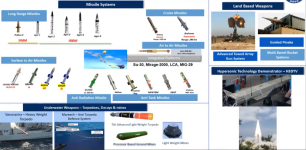So, further diving into the matter, found an old paper among desidoc journals , which discussed about the effect of fuel properties on specific thrust of ramjet engines. Like I was insinuating before, it also indicated the following partFurther to the above post, found that old pdf I was actually searching for, the initial Brahmos ramjet work related, quite old but very accurate & from the DRDL team. You can read through and see why certain parameter were chosen for satisfactory performance. If we try to increase speed to such 4.5mach level almost certainly the design will have to be modified again to satisfy the boundary conditions ie our own ramjet engine will need to be created. Our STAR itself will also have the same mach 3 speed per reports.
SFDR based system can probably reach mach 4.5 range , even touch 5 depending on high energy propellant used. Tradeoff will probably affect the maneuverability of the missile, you have a high maneuver capable Brahmos, but a much higher speed based one will lose energy trying to follow similar flight guidance and pull such maneuver, thereby lose some range. Another negative being high G load due to g force caused by such high speed which may need strong airframe and make it heavier.
Analysis of the ideal ramjet cycle1 reveals the
following: (i) I sp of an ideal ramjet has a local
maximum at the conventional supersonic flight range,
typically between Mach number 2.2 and Mach
number 3.5, (ii) for any operating conditions, the
lower the fuel/air ratio, f = mf /ma, the higher is the
specific impulse of the ideal ramjet.
Now this is for a liquid fuel hydrocarbon based ramjet, like something that uses kerosene as the main fuel. So Brahmos in its current config, if continue to use kerosene as fuel then it can only improve speed upto max envelope of 3.5 mach, which is exactly what I also read/heard in past discussions, that the NG version can have speed 3.5mach range. We can understand the Russsian have abundant of kerosene/hydrocarbon available to them so they used that as the most logical option, cheap & effective. To go to higher mach numbers, we will need much better propellant, solid metal powder based ones that have much higher burn rates.
Later I also came across this paper by 2 IIT Madrs academic scholars, which discussed that although all the research in hypersonic regime so far have been based on scramjet related, it is possible to modify a ramjet into a mach 6 capable hypersonic flight. by using AL based fuel rich propellant. Aluminium, Boron & specially hydrogen based propellants now have high potential compared to conventional ramjet fuel like kerosene which got 2500K flame temp so can not produce enough thrust to sustain mach 6 flight against the drag generated.
Attached both doc below







 LRAShM
LRAShM









